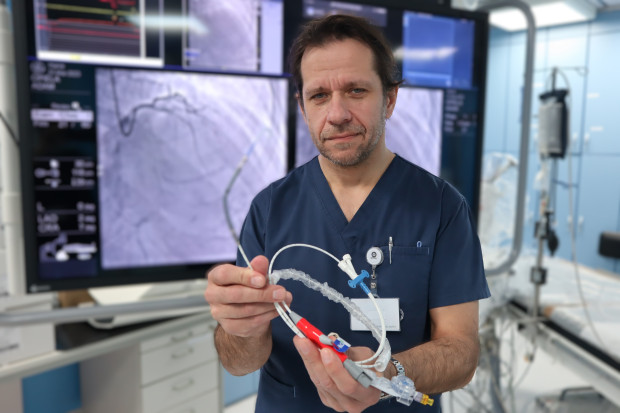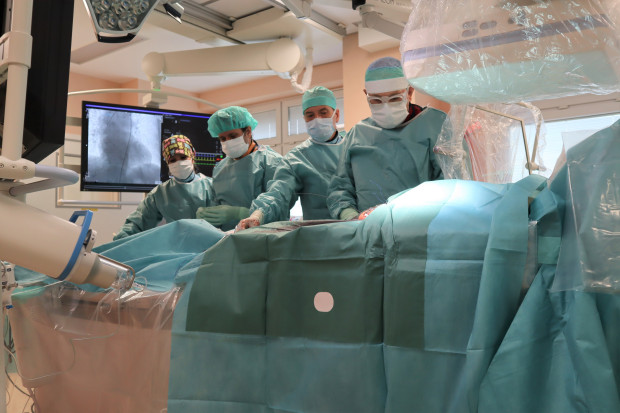An innovative method now available in Poland. It saves the kidneys and the budget.

- About 25 percent of invasive cardiology patients suffer from chronic kidney disease and require protective procedures
- The zero-contrast PCI method developed by the University Clinical Hospital in Opole significantly reduces the risk by enabling angioplasty without the use of contrast
- "No patient who had previously undergone dialysis after a standard procedure required dialysis after zero-contrast PCI," says Dr. Jerzy Sacha from USK Opole in an interview with Rynek Zdrowia
- The method received a jury award in the Start-Up-Med 2025 competition in the "medical/scientific center" category organized by Rynek Zdrowia and Grupa PTWP
Jakub Styczyński, Rynek Zdrowia: How significant a problem is the need to implement treatment for complications after contrast administration?
Dr. hab. Jerzy Sacha, invasive cardiologist, head of the Hemodynamic Research Laboratory at the University Clinical Hospital in Opole, author of the project "Strategia zero - contrast PCI": Contrast-induced acute renal failure primarily affects patients with damaged kidney function. It is estimated that one quarter of patients undergoing invasive cardiology procedures present varying degrees of renal impairment. Such patients require protective procedures during procedures using contrast - on a national scale, this is approximately 40 thousand patients per year.
Treating complications is a burden for the patient, but also for the healthcare system. Costs are generated by prolonged hospitalization, the need for dialysis, not to mention chronic dialysis or kidney transplantation. In addition, fear of contrast and possible dialysis means that patients with kidney damage often do not agree to invasive treatment of coronary artery disease.
We have therefore developed instructions on how to perform percutaneous coronary procedures without contrast (so-called zero-contrast PCI) in such patients and how to perform coronary angiography with an ultra-low contrast dose.

What is the innovative nature of the solution you have implemented? What is its genesis?
In the case of coronary angiography, we are talking about reducing the contrast agent from 50-70 ml to a few, and - in the case of coronary angioplasty - from 150-250 ml even to zero! In addition, we have developed a number of new techniques for performing the above procedures, and we have described the whole thing in scientific journals.
The introduction of such a strategy allowed for a 2.5-fold reduction in the risk of post-contrast renal damage. Moreover, no patient who had previously undergone dialysis after a standard procedure required dialysis after zero-contrast PCI.
What was the genesis of developing this strategy?
The idea was born during my stay in New York ( in 2017 ), where I witnessed a procedure without contrast in a patient with renal failure. After returning, we started developing the method in our center. We performed the first zero-contrast PCI procedure in 2017 on the left coronary artery trunk, which is the most difficult place to intervene among all coronary vessels. It was the first published procedure on the left coronary artery trunk without contrast.
One of the more spectacular cases that we broadcast live to the US was a patient with severe kidney damage who started dialysis two weeks before a zero-contrast PCI procedure. After the procedure, her circulatory system function improved, which resulted in kidney function improvement enough to be able to discontinue dialysis. This significantly postponed the moment of implementing permanent dialysis therapy.
Does reducing the dose or completely limiting the use of contrast affect the effectiveness of diagnosis and treatment?
We have shown in our material that zero-contrast PCI procedures are safe, while ultra-low-dose contrast coronary angiography is as valuable as the standard method. Evidence of efficacy and safety also comes from other centers. When performing such procedures, we use intravascular ultrasound and the anatomy of extracardiac structures that we do not pay attention to with the standard approach (such as vascular shadows, ribs, calcifications in arteries).
If the safety of the procedure requires it, there is always the possibility of injecting contrast, but even in such situations the amount of contrast used is incomparably smaller.

Is this method equally effective in all patients or are there any limitations to its use?
The method allows for a drastic reduction in the amount of contrast in every patient, even if it is not possible to perform PCI completely without the use of contrast. Hence, we can say that the contrast-limiting approach should be used in every patient, because it always brings benefits to the patient. In my experience, simply changing syringes from 20 ml or 10 ml to 5 ml significantly reduces the volume of contrast during coronary angiography and PCI, and there are many such "tricks".
Do doctors need special training to perform procedures using this technique?
Training is the best way to adopt the method. In principle, we should teach young invasive cardiologists how to limit contrast during procedures. Comprehensive information on this topic can also be found in our publication in the journal "Advances in Interventional Cardiology", which was also cited in the American so-called SCAI recommendations.
Are Polish hospitals currently prepared in terms of equipment and organization to use this technology?
Contrast-limiting methods do not require any non-standard equipment. All hemodynamic laboratories in Poland have intravascular ultrasound, which is necessary for zero-contrast PCI. The rest depends on the involvement of the doctors performing the procedures.
What are the plans to further develop or refine this strategy? Can it be extended to other types of treatments?
Each new technique that makes zero-contrast PCI easier to perform contributes to the development of the method. This is happening on an ongoing basis, with the world of invasive cardiology exchanging its experiences primarily through scientific publications. The non-contrast approach can also be used in peripheral vascular procedures and TAVI – such interventions are already being performed in patients at high risk of kidney damage.
Write to the author: [email protected]
Copyrighted material - reprint rules are specified in the regulations .
rynekzdrowia





